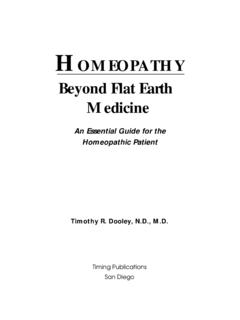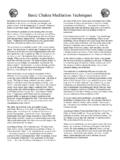Transcription of Comprehensive Qigong and Tai Chi ReviewRJLL0509
1 A Comprehensive Review of Health Benefits of Qigong and Tai Chi Jahnke R, Larkey L, Rogers C and Etnier J ABSTRACT Research examining psychological and physiological benefits of Qigong and Tai Chi is growing rapidly. The many practices described as Qigong or Tai Chi have similar theoretical roots, proposed mechanisms of action and expected benefits. Research trials and reviews, however, treat them as separate targets of examination. This review examines the evidence for achieving outcomes from randomized controlled trials (RCTs) of both. Review Of Qigong And Tai Chi Drs R.
2 Jahnke and L. Larkey - A Comprehensive Review of Health Benefits of Qigong and Tai Chi accepted with revisions, by The Am. Journal of Health Promotion. Do not circulate without the direct permission of the lead author. 2 A Comprehensive Review of Health Benefits of Qigong and Tai Chi Abstract Objective: Research examining psychological and physiological benefits of Qigong and Tai Chi is growing rapidly. The many practices described as Qigong or Tai Chi have similar theoretical roots, proposed mechanisms of action and expected benefits. Research trials and reviews, however, treat them as separate targets of examination.
3 This review examines the evidence for achieving outcomes from randomized controlled trials (RCTs) of both. Data Sources: The key words tai chi, taiji, and Qigong were entered into electronic search engines for the Cumulative Index for Allied Health and Nursing (CINAHL), Psychological Literature (PsychInfo), PubMed, Cochrane database, and Google Scholar. Study Inclusion Criteria: RCTs reporting on the results of Qigong or Tai Chi interventions and published in peer reviewed journals published from 1993-2007 Data Extraction: Country, type and duration of activity, number/type of subjects, control conditions, and reported outcomes were recorded for each study.
4 Synthesis. Outcomes related to Qigong and Tai Chi practice were identified and evaluated. Results. Seventy-seven articles met the inclusion criteria. The 9 outcome category groupings that emerged were: bone density (n=4), cardiopulmonary effects (n=19), physical function (n=16), falls and related risk factors (n=23), Quality of Life (n=17), self-efficacy (n=8), patient reported outcomes (n=13), psychological symptoms (n=27), and immune function (n=6). Conclusions: Research has demonstrated consistent, significant results for a number of health benefits in RCTs, evidencing progress toward recognizing the similarity and equivalence of Qigong and Tai Chi.
5 Key Words: tai chi; taiji; meditation; Qigong ; mind body practice; meditative movement; moderate exercise; breathing. Indexing Key Words: Format: Literature Review Review Of Qigong And Tai Chi Drs R. Jahnke and L. Larkey - A Comprehensive Review of Health Benefits of Qigong and Tai Chi accepted with revisions, by The Am. Journal of Health Promotion. Do not circulate without the direct permission of the lead author. 3 A Comprehensive Review of Health Benefits of Qigong and Tai Chi A substantial body of published research has examined the health benefits of Tai Chi (also called Taiji) a traditional Chinese wellness practice.
6 In addition, a strong body of research is also emerging for Qigong , an even more ancient traditional Chinese wellness practice that has similar characteristics to Tai Chi. Qigong and Tai Chi have been proposed, along with Yoga and Pranayama from India, to constitute a unique category or type of exercise referred to currently as meditative movement (Larkey, Jahnke, Etnier, & Gonzalez, 2009). These two forms of meditative movement, Qigong and Tai Chi, are close relatives having shared theoretical roots, common operational components, and similar links to the wellness and health promoting aspects of traditional Chinese medicine.
7 They are nearly identical in practical application in the health enhancement context and share much overlap in what traditional Chinese medicine describes as the three regulations : body focus (posture and movement), breath focus, and mind focus (meditative components) (Jahnke, 2002; Larkey et al., 2009). Due to the similarity of Qigong and Tai Chi, this review of the state of the science for these forms of meditative movement will investigate the benefits of both forms together. In presenting evidence for a variety of health benefits, many of which are attributable to both practices, we will point to the magnitude of the combined literature and suggest under what circumstances Qigong and Tai Chi may be considered as potentially equivalent interventions, with recommendations for standards and further research to clarify this potential.
8 Objectives Previously published reviews have reported on specific outcomes of either Tai Chi or Qigong , mostly addressing only one of these practices, and rarely taking into account the Review Of Qigong And Tai Chi Drs R. Jahnke and L. Larkey - A Comprehensive Review of Health Benefits of Qigong and Tai Chi accepted with revisions, by The Am. Journal of Health Promotion. Do not circulate without the direct permission of the lead author. 4 similarity of the two forms and their similar outcomes.
9 These reviews have covered a wide variety of outcomes, with many focused on specific diseases or symptoms including: hypertension (M. S. Lee, Pittler, Guo, & Ernst, 2007); cardiovascular disease (Cheng, 2006; M. S. Lee, Pittler, Taylor-Piliae, & Ernst, 2007); cancer (M. S. Lee, Chen, Sancier, & Ernst, 2007; M. S. Lee, Pittler, & Ernst, 2007; Mansky et al., 2006); arthritic disease (M. S. Lee, Pittler, & Ernst, 2007); stroke rehabilitation (Taylor-Piliae & Haskell, 2007); aerobic capacity (Taylor-Piliae & Froelicher, 2004); falls and balance (Verhagen, Immink, van der Meulen, & Bierma-Zeinstra, 2004; Wayne et al.)
10 , 2004); bone mineral density (Wayne et al., 2007); and shingles-related immunity (M. Irwin, Pike, & Oxman, 2004), with varying degrees of support noted for outcomes in response to Qigong or Tai Chi. Other reviews have addressed a broad spectrum of outcomes to demonstrate how Qigong (C. Lan, Lai, & Chen, 2002; Sancier & Hu, 1991; Sancier, 1996; Sancier, 1999) or Tai Chi (Adler & Roberts, 2006; Hogan, 2005; Kemp, 2004; J. X. Li, Hong, & Chan, 2001; Matsuda, Martin, & Yu, 2005; C. Wang, Collet, & Lau, 2004; S. L. Wolf, Coogler, & Xu, 1997) have demonstrated improvements for participants with a variety of chronic health problems or with vulnerable older adults.





